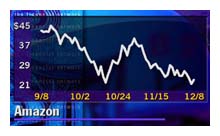|
Spying on Amazon
|
 |
December 8, 2000: 6:06 p.m. ET
CS First Boston analysts go to work in Amazon distribution center
By Staff Writer David Kleinbard
|
NEW YORK (CNNfn) - Securities analysts have been known to go to great lengths to obtain any information that could give them superior insight into a company's financial results. Even the smallest tidbit of information that competing investment banks don't have could lead to trading gains.
To that end, analysts call competitors and suppliers; they interview former employees and industry experts; they dig through tedious SEC filings, examining a footnote buried on page 137. Some analysts have even measured the amount of rust on railroad tracks as a gauge of how frequently companies are moving their merchandise along the rails.
Some analysts from CS First Boston who cover Web retailing giant Amazon.com (AMZN: Research, Estimates) may have set a new precedent this week for just how far researchers will go to obtain information on a company when they signed up to work within Amazon's Delaware distribution center, picking inventory from warehouse shelves and assembling orders.

The CS First Boston team, led by analyst Jamie Kiggen, didn't tell Amazon what they were doing. Rather, they obtained their temporary jobs through Amazon's standard job application process. The temp agencies Amazon uses to obtain seasonal labor apparently felt that investment banking experience at First Boston was a sufficient credential for putting books in boxes.
The First Boston analysts weren't moonlighting to supplement their investment banking paychecks. Their larger goal was to measure the volume of packages moving out of Amazon's Delaware facility, which is estimated to account for 20-25 percent of the company's U.S. unit volume and focuses on fulfilling orders for books, music and videos.
"While it's imprecise to extrapolate trends from a single distribution center, in our view the activity levels at this facility demonstrate that Amazon is highly likely to meet or exceed our December quarter revenue estimate of $1 billion," Kiggen said in a research note issued Friday. "Shipment levels appear to be at least on plan, with a very high backlog of orders to be filled."
Amazon has what it calls a "Delight-O-Meter" on its Web site, which reports in real time the number of units ordered worldwide since Nov. 2. While Amazon has discouraged analysts from using the Delight-O-Meter to estimate the company's fourth-quarter revenue, that hasn't stopped them from doing so. As of Dec. 8, the Delight-O-Meter stood at 21.1 million units ordered.
"The general takeaway from our moonlighting is that Amazon is executing on its near-term and long-term financial and operating goals," Kiggen said in his research note. "Customers are plentiful and active, customer service levels are high, and operations are becoming more efficient."
Kiggen repeated his buy recommendation on Amazon shares and his price target of $60. The company's shares rose $2.06 to $23.44, amid a broad rally on Nasdaq.
Amazon shipped about 20 million items last holiday season, delivering more than 99 percent of them on time, said company spokesperson Bill Curry. Last year at this time, Amazon had seven distribution centers in the U.S. and two in Europe. Now, the company has eight in the U.S., three in Europe and one in Japan. The company had 15 million customers in its database last November, versus more than 25 million now.
Happy to have a capable worker
"This time of year, it's all about delivering for the customers," Curry said. "We contract with a number of temp agencies to provide us with seasonal help. People are screened by the temp agencies and hired by them if qualified. It doesn't bother me that a very capable worker like Jamie spent a day working at Amazon helping us meet our commitments to customers."
Amazon doesn't see any need to change its hiring procedures as a result of the incident.
"I don't think it says anything about the process we use," Curry said.
Curry declined to comment on how he would feel about a journalist getting a temp job at Amazon and writing about his or her experiences inside the company. Kiggen wasn't available for comment Friday.
Securities lawyers said that the information CS First Boston obtained would have to be both material and confidential for there to be a risk of an SEC enforcement action for insider trading.
"The securities laws say you cannot make use for personal gain of confidential information you obtained in a fiduciary capacity," said Robert Litt, an attorney at Arnold & Porter in Washington, D.C. specializing in white collar crime. "If the First Boston analysts made no use of it, then there is not an issue. There also is an issue of whether the information they obtained was confidential and material."
The fact that the First Boston analysts were lowly warehouse workers is irrelevant, Litt said.
"The position you are in within the corporate hierarchy is irrelevant. It's not who you are, it's what you know," he said.
Harvey Pitt, a securities lawyer at Fried, Frank, Harris, Shriver & Jacobson who was general counsel at the SEC from 1975-78, said he would advise a client against doing what the First Boston analysts did, since it could create a perception of trading on inside information.
"I would advise them against it," Pitt said. "Of course, one would have to distinguish between material and non-material information. But the analyst, at a minimum, becomes a temporary insider."
"If the analyst is communicating his findings to a select group of people and it might lead to proprietary trading by his employer, then you might have problems. But if he is publishing information for a widespread audience, I have less of a problem with it," Pitt said.
"The Delaware distribution center is our second-smallest," said Amazon's Curry. "I think it would be hard to draw conclusions from it about the whole company." 
|
|
|
|
|
 |

|

